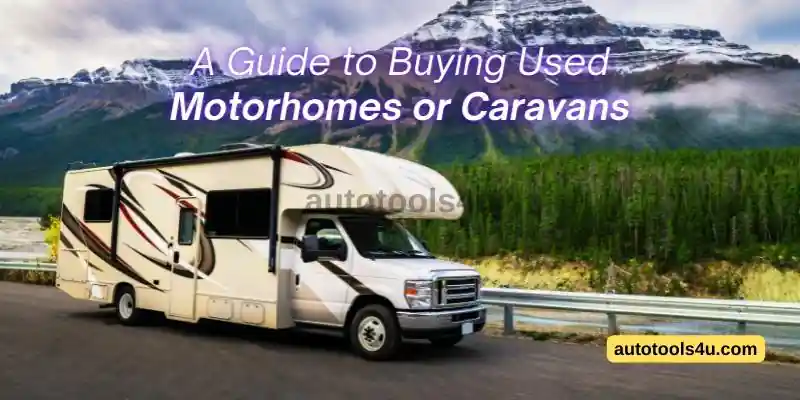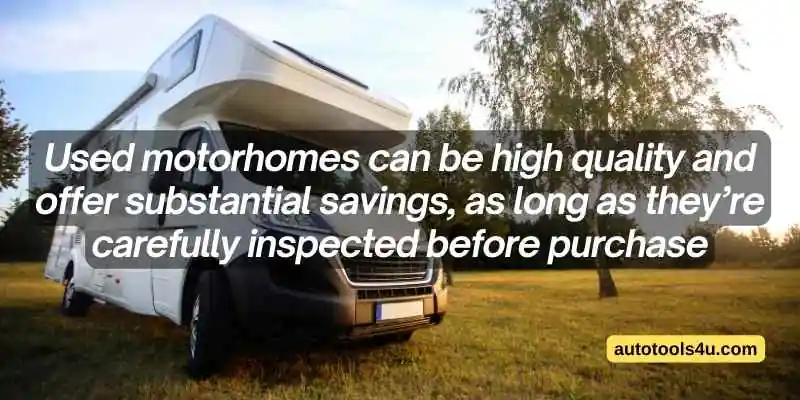If you’re a wanderlust-driven adventurer seeking the perfect balance of freedom and comfort, then purchasing a used motorhome might just be your ticket to a life on the open road. In this comprehensive guide, we’ll walk you through everything you need to know to make an informed decision when it comes to buying a used motorhome. From budget considerations and inspection tips to understanding different types and models, we’ve got you covered. Get ready to embark on an exciting journey as we help you navigate the world of used motorhomes and ensure that your road trips are nothing short of extraordinary. Let’s dive in and discover the keys to hitting the road in style!
Things to Consider When Buying a Used Motorhome 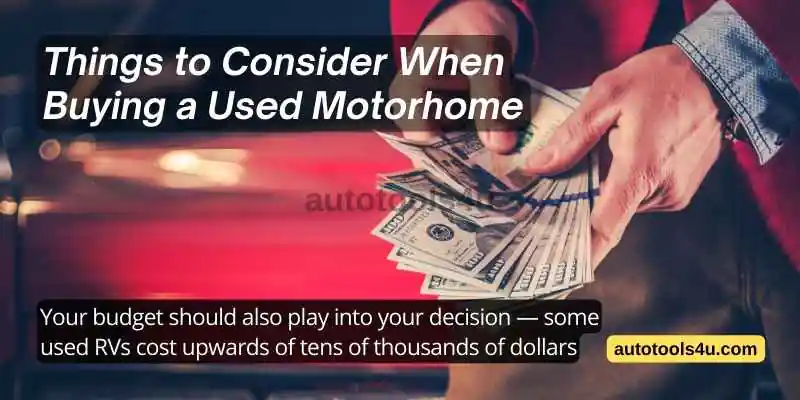
Before you make a purchase, it’s important to evaluate what you will be using the motorhome for. If it’s just for traveling around the state, a smaller RV may be suitable. However, if you intend on going on long trips and need something spacious and comfortable, then a larger RV might be more appropriate. Your budget should also play into your decision — some used RVs cost upwards of tens of thousands of dollars! There are many different types of RVs available on the market today: some have beds that fold down into seats while others come with full kitchens and bathrooms. It all depends on what type of experience within an RV suits your needs best!
What are the benefits of buying used motorhomes? 
When you purchase a used motorhome, you can save money and reduce risk. The price of any new vehicle will depreciate significantly over time (especially if it’s a gas guzzler), but by buying used, you can avoid this problem. You also have more options available to you when searching for a used motorhome—in fact, many dealerships don’t even sell new motorhomes.
Additionally, buying used is much more flexible than purchasing new because there’s no need for financing or salesmen pressuring you into making an immediate decision about your purchase. Finally, there’s no sales tax or registration fees on purchasing used vehicles in most states; this means that your total cost will be lower than it would be if you purchased new instead!
What to look for in a used motorhome 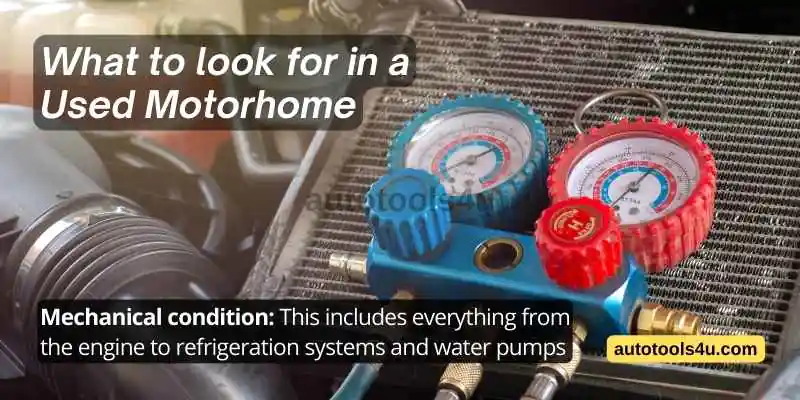
The most important thing to know about buying a used motorhome is that you’re not just buying a vehicle. You’re also purchasing the memories and experiences of its previous owner—so it’s important to make sure that those experiences were good ones, with no major problems or issues left unresolved.
When shopping for used motorhomes, here are some things you should look for:
- Mechanical condition: This includes everything from the engine to refrigeration systems and water pumps. Be sure that all of these components work properly, because they’re often vital to your safety while traveling in an RV.
- Interior and exterior conditions: Think about what you need in terms of space, storage compartments (or lack thereof), decorating style (if applicable), etc., then evaluate whether the interior layout works for your needs by examining photos of both sides of each unit on offer. If possible, go visit multiple models before making your final decision so that you can compare them side-by-side in person; this will help prevent wasting time trying out vehicles that don’t meet all of your criteria right off the bat!
Motorhome or Caravan? what are options 
It is important to understand the difference between a caravan, campervan, and motorhome. A caravan is towed by a car, whereas a motorhome has its own engine and can be driven on the road.
A campervan is similar to a motorhome in that it can be driven on the road but it does not have water tanks or toilet facilities of its own – these must be provided by you (for example in your car) when you are staying overnight at campsites or other places with basic facilities for vehicle parking overnight.
Both types of vehicle will require regular maintenance such as servicing, checking tyres, etc., so cost savings should not be your only consideration when making this decision because if you do buy an older model used vehicle then it may require more frequent attention than newer models which have had more use in the past few years since they were built-in factories overseas prior sale here in Australia today!
Buying used Motorhomes – Your Goals? 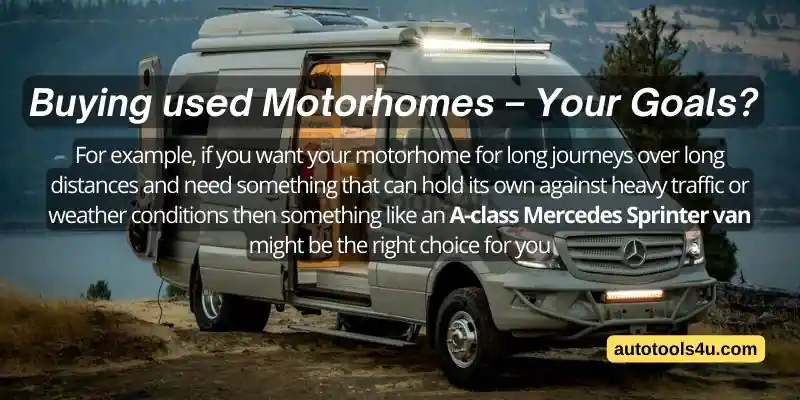
To start, you need to answer a few questions:
- What do you want to do with the motorhome? This is a vital question, as it will impact everything from how far you can travel each day (and thus how much money you’ll spend on fuel) to what kind of campsite facilities are available. For example, if you want your motorhome for long journeys over long distances and need something that can hold its own against heavy traffic or weather conditions then something like an A-class Mercedes Sprinter van might be the right choice for you. However, if all your plans involve shorter expeditions through urban areas then maybe something smaller like a Fiat Qubo could suit better.
- How much do I want to spend? This may seem obvious but if all else fails consider what budget limits are there before making any decisions on which type of vehicle is right for YOU!
Used Motorhomes – Price Range 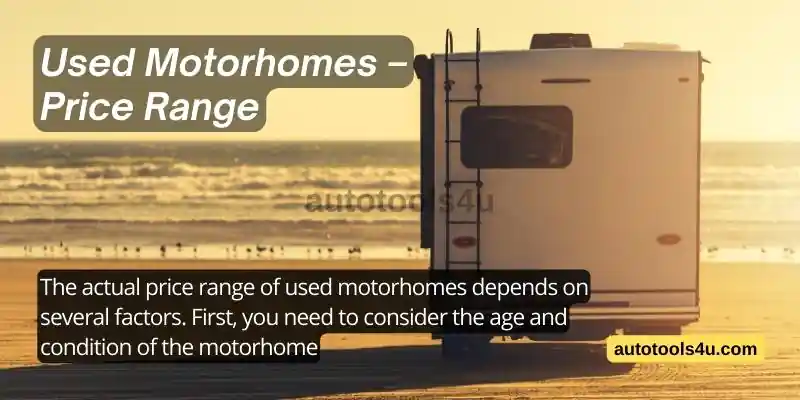
The actual price range of used motorhomes depends on several factors. First, you need to consider the age and condition of the motorhome. A newer model will obviously cost more than an older model, so this is one important factor that will affect the overall price range. The condition of a used motorhome can also affect its price range; if there are signs of damage or wear-and-tear in certain areas (such as carpet stains), that could result in a lower asking price because it would decrease demand for purchasing this particular unit.
The second factor that affects a buyer’s decision on what they should pay for their future home is mileage. You’ll usually find that older models aren’t as popular among buyers because they tend to have higher mileage on them from previous owners who have driven them around town or taken them on long trips across states or countries. This means there may be some wear-and-tear issues with these vehicles due to so many miles being put onto them throughout different journeys; however, some people love buying these types of cars because they’re looking for something unique/different and don’t mind working hard at fixing things up before taking off again!
Used Motorhomes – Brands to consider 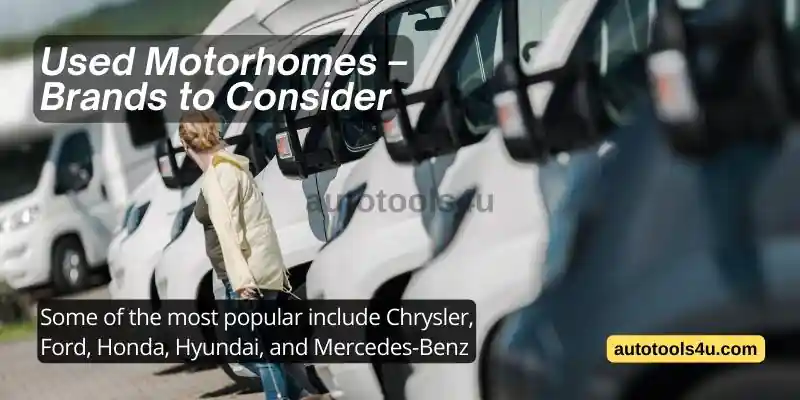
When you’re shopping for used motorhomes, you’ll quickly discover that there are a lot of different brands out there to choose from. Some of the most popular include Chrysler, Ford, Honda, Hyundai, and Mercedes-Benz. Other great options include Nissan and Toyota as well as Volkswagen and Volvo.
The first thing you should do when looking at different brands is asking yourself what kind of style you like. Do you want something sleek and modern? Or maybe something with more traditional lines? Additionally:
- What are the main features I need in my motorhome? Will it be used primarily for camping or long-distance driving?
- How much power am I looking for? Should we get two engines or just one (or none)?
1. Vehicle history check 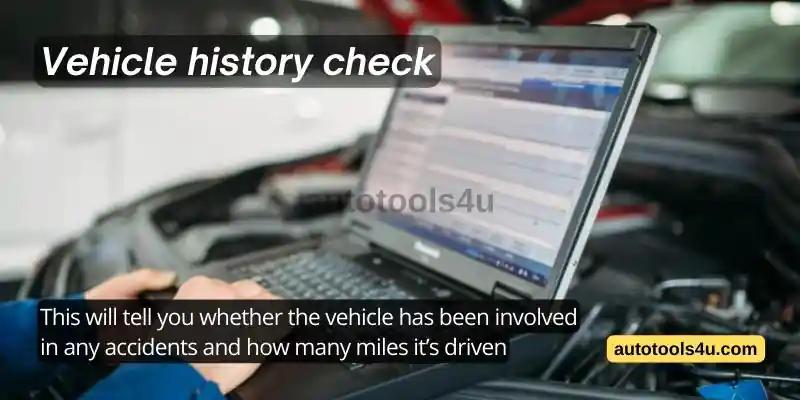
Before you commit to buying a used motorhome, it is important that you do a vehicle history check. This will tell you whether the vehicle has been involved in any accidents and how many miles it’s driven. You can also find out if the vehicle has been registered or had insurance in certain states. The service history of a motorhome tells you how well it has been maintained over time and whether the previous owner was meticulous about his or her routine maintenance schedules, so this is another thing to look into before making your decision. Finally, emissions are important because they measure what kind of gas mileage engines get (some types are more efficient than others) and determine whether they meet emission standards set by state governments around America (for example).
When researching these things online at sites like Carfax or AutoCheck, be sure not only read through everything but also to look for any discrepancies between what’s being said about each part of an inspection report versus other sources such as other websites with similar features; this will help ensure accuracy when comparing one site against another!
2. Book a test drive 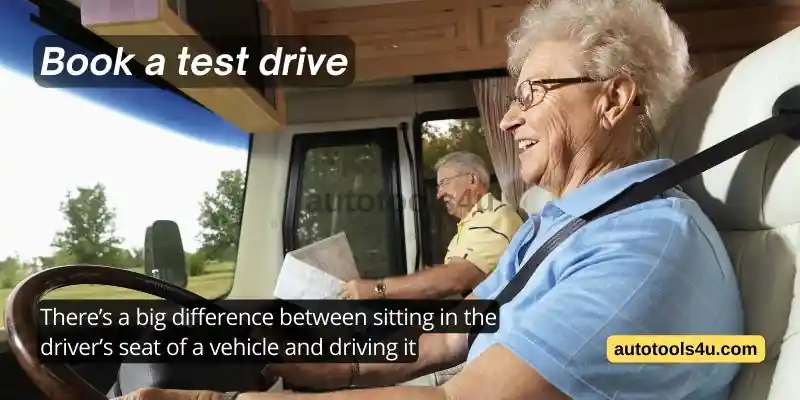
There’s a big difference between sitting in the driver’s seat of a vehicle and driving it. If you’re thinking about buying a used motorhome, book a test drive to see how it feels, sounds and drives.
- How does it feel? Does it feel like you’re sitting at home on your couch? Is there enough leg room? Are the controls easy to reach and operate?
- How does it sound? Does the engine have any odd noises or vibrations when at idle or under acceleration/deceleration? Is there any excessive wind noise inside the cabin while driving on highways or on slower roads at higher speeds (60 mph). Do these noises increase if you accelerate aggressively (e.g., pass another car)? If so, this may be an indication that major repairs are needed soon.
- How does it drive? Does the steering feel light off-center with no resistance as you turn into corners but stiffen up when turning hard into corners (which indicates worn bushings in front suspension components)? Does turn radius feel tight after parking next to curbs or bumpers of other vehicles in parking lots without rubbing against them—or is there enough clearance available when turning around corners while parked so as not to scrape any exterior paint/body panels against curbs/parking lot bumpers due to poor alignment angles between wheels/suspension components (which could also indicate worn bushings).
3. Exterior inspection 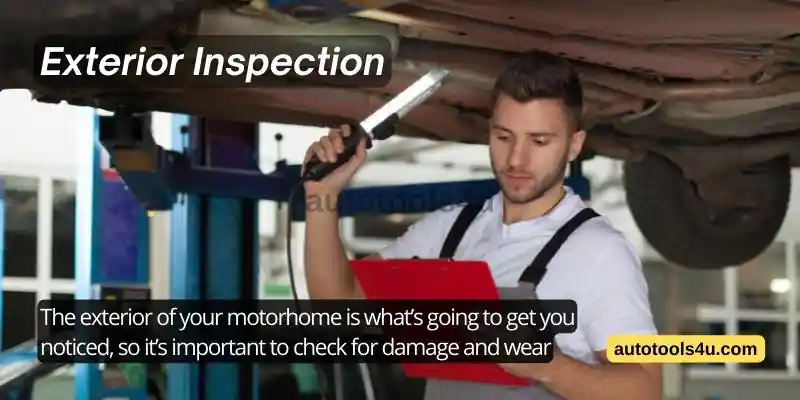
The exterior of your motorhome is what’s going to get you noticed, so it’s important to check for damage and wear. Take a good look at the paintwork, both inside and out. You’re looking for rust, dents, cracks in the paint and chipped/scratched paintwork. Take this opportunity to check over any light fittings on the outside of your potential purchase too—they should be working well and securely attached. Check mirrors are undamaged too; if they’re smashed up or broken off entirely then repair costs could be costly (but don’t let that put you off if everything else seems great).
Check wheels as well: loose ones will mean an expensive fix down the line!
4. Interior inspection 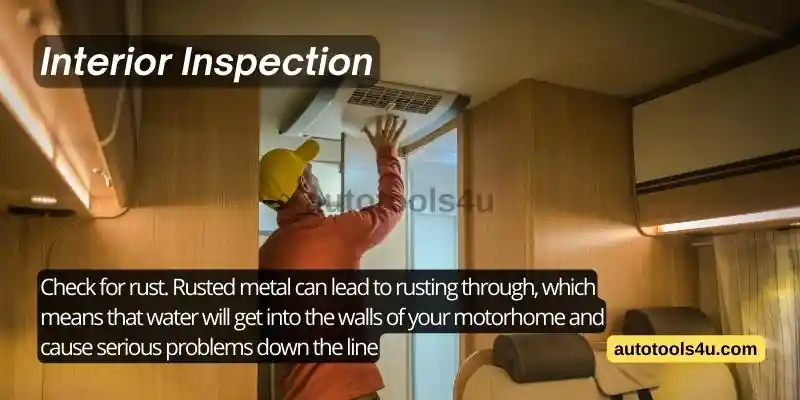
- Check for damage. The interior of a motorhome can be subject to all kinds of abuse, so you should always check for signs of wear and tear. Remember that this is where the family will live and sleep, so there’s no room for mistakes here!
- Check for rust. Rusted metal can lead to rusting through, which means that water will get into the walls of your motorhome and cause serious problems down the line.
- Check for water damage. Water damage often goes hand-in-hand with rusting, but it can also just be something that happens over time—maybe while you’re living in an RV park during an extended stay or something like that! Either way, it’s good practice to make sure there isn’t any sign of this before buying a used motorhome.
5. Self-containment/habitation check 
Now it’s time to get inside the motorhome and see how it looks.
The first thing you want to do is check all of the gas, water, and electrical systems. Check these by turning on all the appliances and lights. If everything works, that’s great! If there are problems though, make sure you’re aware of them before moving forward with your purchase. While turning on all these appliances may seem like an unnecessary step, it could save you from having to deal with any expensive repairs once you’ve purchased your motorhome.
Next up: bedding! You’ll want to make sure that no bedding has been stained or damaged since its last use. You can also inspect the mattress itself for rips or tears before deciding whether or not this used motorhome is right for you (and your wallet).
If there’s a toilet inside this used camper van – which we assume there likely is – then take some time to check out its condition as well as its functionality (can I flush this thing?). The same goes for any showering facilities: look at both their aesthetics as well as their functionality so that they meet your needs when traveling in an RV full-time or just camping occasionally during summer months.”
Used motorhomes can be high quality and offer substantial savings, as long as they are carefully inspected before purchase
Purchasing a used motorhome offers the chance to save a lot of money, but you need to make sure that it’s been well cared for and hasn’t suffered any major damage. Some things to look for are:
- A solid frame with no rust or corrosion
- No leaks in the roof or floor
- No cracks in the windshields or windows (and if there are cracks, how much do they affect visibility?)
